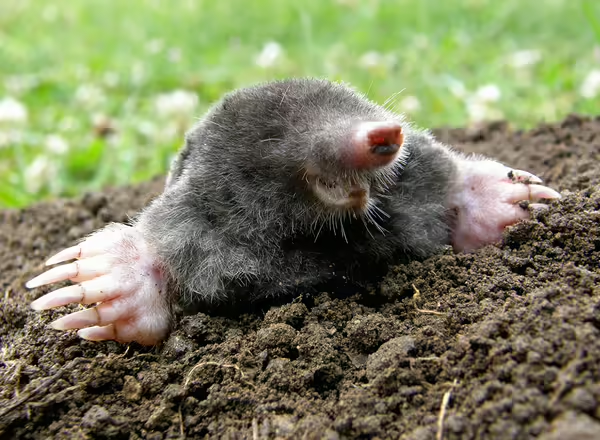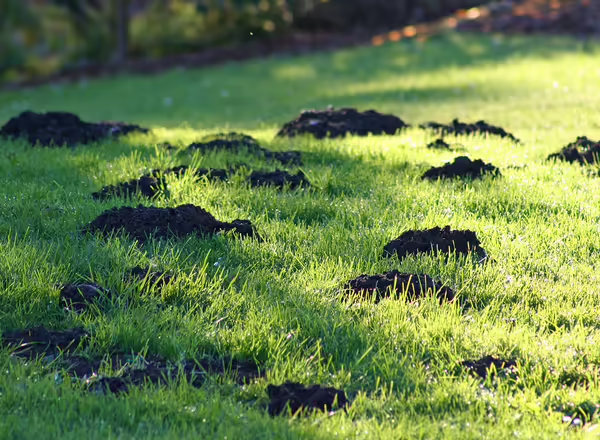
Eastern Mole
Moles, scalopus aquaticus, are a recurring problem where turf areas are next to meadows, forested areas, and other areas where mole populations yearly produce offspring that invade those turf areas. Mole damage can occur annually.
Symptoms
Their subsurface tunnels can create mowing problems, can cause turf dieback by exposing turfgrass roots to drying air, and are aesthetically unpleasing.

Moles are 6 to 8 inches long, short-legged, blackish, heavy-bodied mammals with elongated snouts, short tails, and broadened, shovel-like front feet. They are better known by their subsurface tunnels, where a ridge of sod that is several inches wide is pushed up 2 or more inches. They also make deeper tunnels 6 to 10 inches below the surface in which they rest and rear young. Large mounds of loose soil on the surface are created by the mole's depositing soil dug from deep tunnels.
Subsurface tunnels can be divided into feeding tunnels and main tunnels. Feeding tunnels tend to meander or wind back and forth. They commonly dead-end without joining another tunnel. Feeding tunnels are created by the mole when searching for food and are rarely reused. Main tunnels are straighter tunnels that connect other tunnels or mounds of loose soil. These main tunnels are used almost daily by the mole.
Moles spend the winter deeper in the soil. As spring approaches, they burrow closer to the soil surface, creating the first subsurface tunnels when the root zone soil temperature is warm enough for earthworms to be active. They feed heavily throughout the spring, summer, and into fall when cooling temperatures reduce food availability.
Moles reproduce in the spring and apparently only have 1 litter per year. Much reproduction occurs in stable, natural areas where there is plenty of food such as meadows, old fields, and wooded areas. Young moles leave the home range and are commonly the ones that become pests in managed turf. Since moles normally have a home range of 1 to almost 3 acres, it is likely that mole tunnels in a residential lawn are being produced by a single mole.
Management
Control moles by setting mole traps across main tunnels. There are two main kinds of traps. The harpoon trap is set by mashing down a portion of tunnel and setting the trap across it so that the spring-loaded spikes are just penetrating the soil. This makes it unlikely that pets or children will be harmed by the trap. As the mole comes through the tunnel and pushes up the soil and trigger, the trap is sprung, killing the mole with the spikes. The choker trap sets across the tunnel and squeezes the mole to death as the trap is sprung. Main tunnels can be distinguished from feeding tunnels by the tips given above or by mashing down portions of each tunnel and marking it off to the side with flags or other markers. Damage to main tunnels will be repaired within a couple of days.
Various repelling plants, such as castor bean, will be effective in repelling moles under some conditions. There are also devices that put vibrations into the soil. These may be effective for a period of time, but eventually the moles are likely to adapt to them and enter the turf area.
Moles feed heavily on earthworms; for that reason, the use of insecticides to kill grubs and other insects on which they also feed is frequently unsuccessful in ridding an area of them. There is a pesticide bait that is effective in controlling moles; it is available on an artificial worm and also as a liquid. Main tunnels are baited by inserting either the artificial worm or drops of the pesticide into a hole punched in the tunnel. Repair the hole in the tunnel after the bait is inserted. Other chemical toxicants that are supposed to poison moles are usually not effective because they are either a vegetable-based bait that the moles do not eat or a gas that escapes through the shallow subsurface tunnels.

Turf
- Annual ryegrass (Italian ryegrass) (Lolium multiflorum)
- Bermudagrass (Cynodon spp.)
- Creeping bentgrass (Agrostis palustris [A. stolonifera])
- Fine fescues (Festuca spp.)
- Kentucky bluegrass (Poa pratensis)
- Perennial ryegrass (Lolium perenne)
- Roughstalk bluegrass (Poa trivialis)
- Tall fescue (Festuca arundinacea)
- Zoysiagrass (Zoysia spp.)